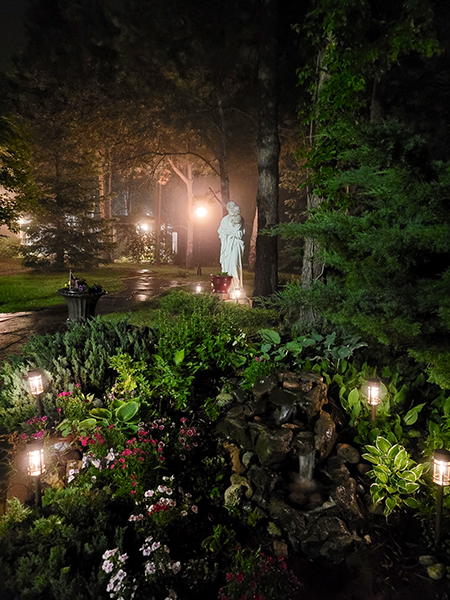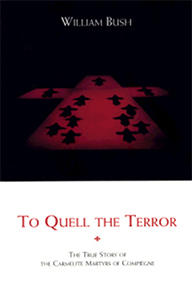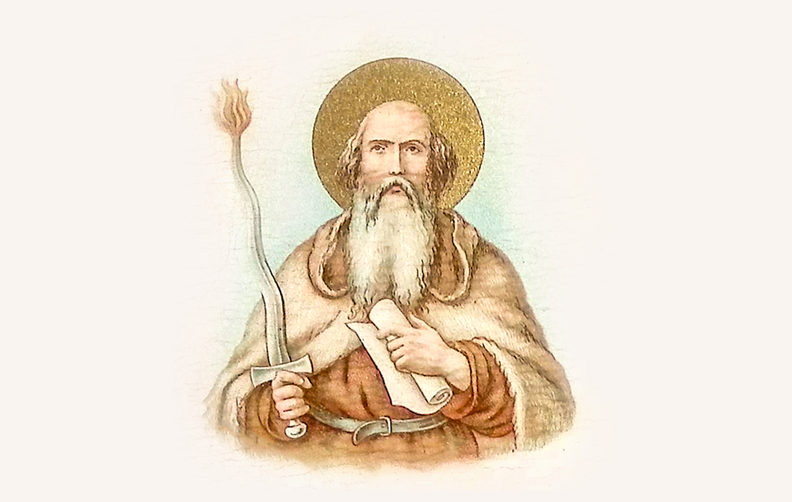
Prophet of Carmel
“O great Saint Elias, who was raised up by God to restore the worship of the one true God among His people, look down upon poor suffering humanity; convert those estranged from God; restore the one true Church of Christ among all nations, that by thy prayer the just chastisement due to our sins and ingratitude may be averted, and that peace and God’s justice may reign everywhere.”
– Excerpt from Prayer to St. Elias
Dear Friends of Carmel,
July is clearly THE Carmelite month. We send in advance of the Feast of Our Lady of Mount Carmel our greetings and prayerful best wishes for a feast day of holy joy and peace.
We would like to take the opportunity of this newsletter to honor Our Blessed Mother by honoring the one who, it might be said, initiated all Marian devotion. Centuries before Our Lady was born, on the top of Mount Carmel, St. Elias had a vision – a small cloud bringing rain to a drought-stricken Israel. Through his deep and mystic prayer, he understood through this vision that a virgin would bring forth a redeemer. Attached to the cave where he had this vision is the most ancient chapel erected in honor of Our Lady of Mount Carmel. It dates back to the year 83 A.D.
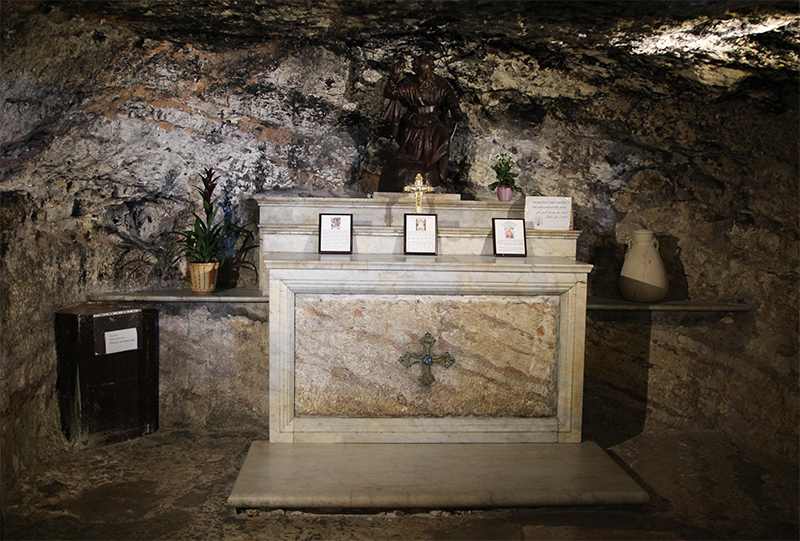
St. Elias, the founder of the Carmelite Order, is not a Saint who has popular or wide spread devotion. His Feast day on July 20th is not celebrated outside the Order of Carmel. Who was this almost myth-like man? He went about rebuking kings, challenging pagan priests, raising the dead to life, and seemed even to have the elements of fire and rain at his command. And what is more, he has not yet died. He was taken up to Heaven in a fiery chariot and will return again to battle the anti-Christ just before the end of all time. These stories are so astounding and his vocation so mysterious, that there is a tendency to forget that he was indeed a man of flesh and blood like all of us. We may fail to see the relevance of his extraordinary life in the context of our own, and so there are very few devoted to him.

A wonderful book, a favorite book of our Community, brings the Old Testament story of St. Elias to life: The Prophet of Carmel. The author, Rev. Charles Garside, breaks down each part of his story, showing us the many facets of the man who is often mentioned in the Bible, but is really so little known. He was a man of stalwart faith, strength and boldness; but also a man who knew and admitted his weakness and had a compassionate heart for those who suffer. Intimidating to all who opposed God, he also had a magnetism that drew many men to follow him and his way of life, laying the foundation of the first religious community, the “Sons of the Prophet” – the origin of the Order of Carmel.

Through The Prophet of Carmel, we become well acquainted with this Old Testament Saint, since the author brings the events of his life forward to our modern times, making them relevant and relatable. Father Garside wisely applies the errors of those days to the fallacies of our own, and we learn essential, very practical lessons from this Saint for living our own Christian life as Catholics. How can we help but remember in all of this the lessons from Fatima about sanctity through fidelity to daily duty? This book is a must read, not only for Carmelites and those who embrace Carmelite spirituality, but for all who fight the daily battle to live a good Catholic life in a world that is turning ever more away from God.
We share with you below a few excerpts from the book, which will give you some of the practical, real-life, modern day reflections Rev. Garside offers on the character and story of St. Elias, God’s great prophet. Although they were written over one hundred years ago, it is impossible not to find them ever more relevant today!
“How long halt ye between two sides?
If the Lord be God follow Him; but if Baal be god, follow him.”

Although he knew perfectly well that numbers of the people were entirely devoted to the worship of Baal, and had no scruples about their iniquity, yet he also knew that there were others, who, not being so hardened, tried to make a compromise, and serve God and Baal at the same time. There were waverers and doubters among the people, and therefore, instead of denouncing the whole body with one sweeping anathema, he took for granted, with thoughtful tenderness, that the mass of them were sinning rather through sluggishness, indecision, and instability than from a downright settled apostasy. The truth of the language of Elias, though elementary, needed to be continually impressed on the minds of men. There are but “two sides,” that of God and of Baal. By Baal is to be understood everything which not being on the side of God is therefore His enemy. “No man can serve two masters.” One of the most fatal delusions to which we are liable is the supposition that we need not commit ourselves to the service of God so exclusively as not to allow ourselves some degree of license in following our own tastes and passions, even though they are, when fairly judged, recognized to be inconsistent with the Divine Will. “You cannot serve God and Mammon.” This is the unalterable truth, but the devil is perpetually whispering to the souls of men since Adam and Eve: “You can! Try to make the most of both worlds; strike a bargain, so much of the spirit and so much of the flesh; so much of your own will and so much of God’s will; so much of this world and so much of the next; take the philosophical golden mean; be not great saints nor great sinners.” How many are caught in this snare! Upon them will fall heavily the condemnation implied in Our Redeemer’s own solemn declaration: “He that is not with Me is against me.” (Chapter 8)
“It is enough for me, Lord,
take away my soul, for I am no better than my fathers.”
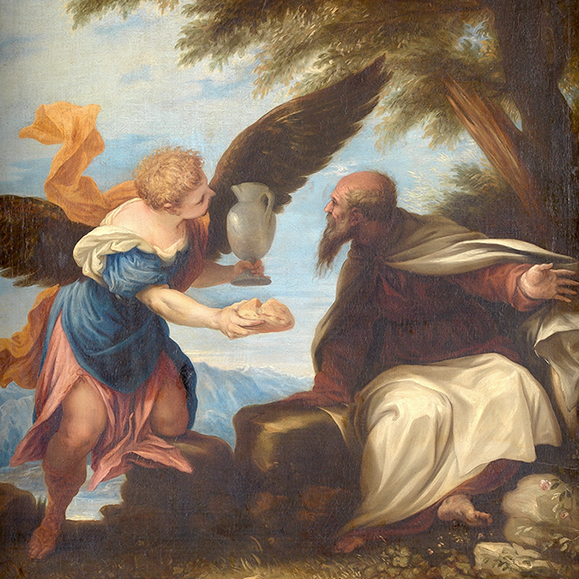
Thus far nothing but moral greatness has characterized the conduct of Elias. He has run his course like a giant. Even giants, however, can stumble, and there are spots upon the sun. It is a fact as startling as it is full of warning to us all, that after his signal victory over the idolatrous prophets, Elias suddenly lost his former courage. Who can tell what the morrow will bring forth? No past victories over temptation, no advances in holiness however great, can guarantee us against a future fall. There are two dangers which we must earnestly avoid: an over sanguine reliance upon our past successes, and forgetfulness that, unless we incessantly pray for fresh strength, our old force will evaporate. The conduct of Elias warns us also of the difficulty in preserving tranquility and courage when our course is not perfectly clear. When God revealed to Elias his duty, and gave him definite commands and distinct work, he walked securely. Fear came upon him precisely when the future was uncertain. It is not nearly so hard to be courageous when our path is clear before us, as it is to be courageous when we have to wait for light, and perhaps suffer until the Will of God be unmistakably known. There is but one security against a disheartening breakdown in the hour of trial, but one remedy for cowardice, but one fountain of vigor that will not dry up under the change of events. Our motive in all things must be the will of God. (Chapter 11)
“He stood up, as a fire”

The world and the devil were never so successful as they are now in pretentiously disguising error under the garb of truth. Vices are enshrined as virtues in the attractive temple of falsehood. Immorality is idealized. Debased views of God and His creation, of the soul and the body, are openly processed in circles of rank and intellect. False doctrine is not only tolerated in the “high places” of social life, and is termed, as if in satire, “sound learning.” Presumptuous skepticism is canonized by popular acclamation, as not only a right but a duty, and the very perfection of mental and moral freedom.
These are some of the hostile elements with which our present life is perilously charged. How can this array of foes be successfully met without a clear sighted and persevering courage and how can this courage be obtained?
Every Christian is bound, according to his means and opportunity, to confront, denounce and resist the enemies of God. The war has to be waged by speech, by writing, by protests, by authority, by active and passive opposition, by sufferings, and by various other modes which need not be mentioned in detail. No class is exempt from military service in the great conflict which is perpetually raging. All are called to the ranks, no matter what may be their individual temperament or temptations. The contest is as unavoidable as it is difficult, but with the grace of God we shall succeed if we are “strong in faith.” “This is the victory that overcomes the world, even your faith.”
Our adversaries may surpass us in station, talent and accomplishments. They may be clothed in them from head to foot, and we may, like Elias, be alone and unarmed, but we shall be the real “men of God.” We shall deliver our message without quivering; and though our personal Achab, whoever he may be, may refuse to believe in our words, we shall nevertheless, have bourne testimony to the true God.” (Chapter 1)
Can we not recognize in these compelling reflections today’s society and also ourselves? St. Pius X said of his own day, just 100 years ago, “All the strength of Satan’s rein is due to the easy going weakness of Catholics.” Could we not say the same today? Could we not say that the reason Satan has made such inroads is because he is often only met with a half-hearted resistance? How much we need the spirit of St. Elias! His unswerving fidelity, his clear, unclouded faith and untainted orthodoxy, both bold and uncompromising, in upholding the rights of God – oh, that they could always be ours! Today’s society, in every possible way, teaches that compromise is a virtue – the only virtue. To condemn error is the only sin. The “live and let live” attitude rules to such a degree that we must not only tolerate, but we must give sanction to the errors around us, if not explicitly by word and deed, then at least by our silence. Everyone must have the absolute right to do, or be, or demand whatever he wants… except God, or those who speak on God’s behalf.
St. Elias was given an inconceivable mission, to stand as God’s faithful and true servant in a society that was crumbling into paganism and sin; and to call the fallen Israelites back to the true worship of God. Certainly, the same can be said of the true Christian’s mission in today’s world. There are many Achabs to be confronted – in personal life, in government, even within the ranks of the Church. There are many false priests to be challenged, who would have us follow a path away from the true God and towards the false gods of today. The errors are the same. The enemies are the same. The challenge is the same. And the prayerful, faithful fight and victory must be the same.
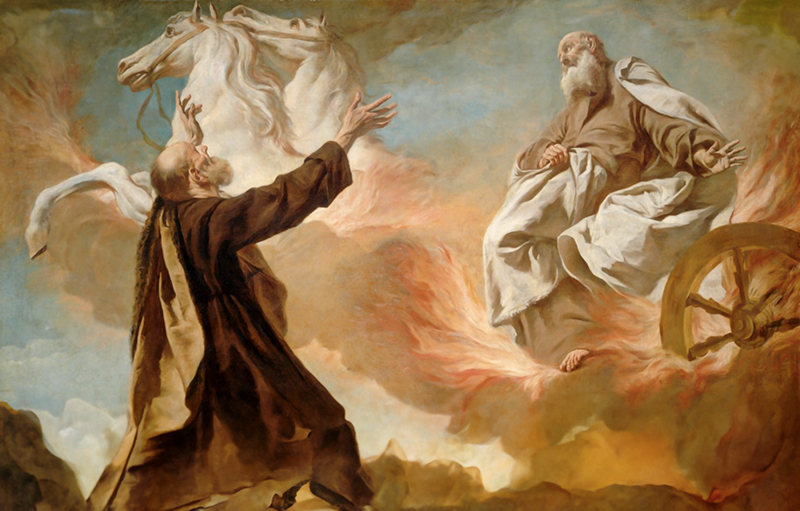
We must pray in the spirit of Elias, who stood in God’s presence with fear and reverence, always ready to combat His adversaries, learning trust through his failures, and finally hearing God’s voice in “the gentle air” and the “still, soft voice” – the affirmation that nothing is out of God’s holy will and power to accomplish for good. (3 Kings 14:10) When Elias returns in the last days (Mal. 4:5-6), may it not be his sorry duty to rebuke Christians who live then – whether they be Carmelites or not – with the words “How long halt ye between two sides?” But rather may we be able to say with him the words which have become enthroned as the motto of all Carmelites: “With zeal I have been zealous, for the Lord God of hosts.”
Through Our Lady of Mount Carmel,
Your Carmelite Sisters
*New Brown Scapular Designs*
Of course with the Feast of Our Lady of Mount Carmel right around the corner, we cannot send a newsletter without at least mentioning the great Carmelite Marian sacramental of the Brown Scapular. We have spoken in past newsletters and on our devotions page about the brown scapular at length, its history, meaning, and privileges. If you are not familiar with this devotion, then we would encourage you to read more!

For many years, we have talked among ourselves about adding a full-color version of the Scapular to our website selection. But only now have we been able to put our ideas and resources together to make it happen. The beautiful new images are printed on a heavy satin and stitched to our 100% wool fabric. To have the 100% wool is the only requirement for the scapular. In fact, it is not necessary to have any images or emblems; but they have long been added as a devout ornamentation: often images of the Blessed Mother, the words of the Scapular Promise, sometimes the souls in purgatory (in reference to the Sabbatine privilege), the Carmelite Shield, or other Marian symbols.

We offer two styles for this new color scapular. For both, Our Lady with the Scapular Promise is on the front. One style then has an Ave Maria symbol with the 12 stars (like on the Miraculous Medal, symbolizing the 12 tribes of Israel) on the back. The other style is a little bit different, since we chose the Carmelite motto with an image of St. Elias. Since the scapular is often called the livery or armour of Our Lady’s army, could it not then also be said that the words of St. Elias, “With zeal I have been zealous,” are our battle cry? When considering how we might promote devotion and make something in honor of our great patron and founder, we thought it a fitting design to put the Carmelite motto on a special scapular. And why not take advantage of the beautiful colors and detail of fabric printing technology to include an image of the Saint himself as well? We are hoping to encourage and spread devotion to him, and through and with him to our Blessed Mother. He was, after all, as we mentioned at the beginning of our newsletter, the first to perceive and understand Marian devotion in God’s plan for His people – and the first general in her army.
We hesitate to call these scapulars “special edition” scapulars, since we can and will make more if the demand is great enough. But presently we do have only a limited supply on hand ready to ship. It will be first come, first serve for now, until we have been able to produce in numbers a good supply. Understand that there is still hand work involved in the making of this special scapular!
It might be interesting for you to know that it was St. Elias who inspired the Carmelites (and many other religious orders) with the stipulation that their clothing be made of wool and/or other natural fibers. The Brown Scapular is meant to be a smaller version of the scapular worn by Carmelites as part of their holy habit. St. Elias (and many of the other prophets in imitation of him, including St. John the Baptist) wore the skins of animals and a leather belt. This clothing, made from natural materials and not the fine fabrics of the rich and powerful, is a sign of detachment from the world as well as poverty.
Carmelite Supplement for St. Elias’ Feast
As mentioned above, the Feast of St. Elias is a major Feast in the Carmelite Order and is celebrated with its own proper Mass and Divine Office. For those who may wish to join us in reading the fine scripture passages and praying some of the special prayers and hymns on his Feast day, we have uploaded these “propers” as a .pdf on our website (English translation for the Divine Office and the Mass texts). Please feel free to print and use for your own personal devotion!
New Catholic Incense Sticks
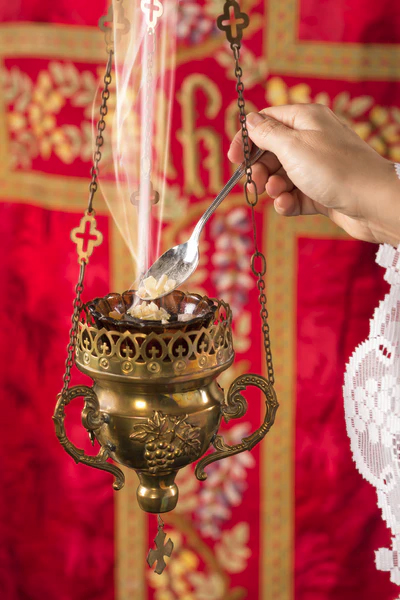
The book of Exodus (30:34-38) records that God commanded the use of incense in Divine worship, and the Jews rightly understood it as a form of sacrifice, that is, the irrevocable surrender to God of something precious and valuable. It was perpetually burnt before the altar, not only as a sacrifice, but as a symbol of unceasing prayer and worship. The New Covenant did not abandon the use of incense, for it is used in the liturgy of the Church at High and Solemn Masses, as well as for para liturgical ceremonies such as Benediction of the Blessed Sacrament and processions. In liturgy, the use of incense symbolizes the act of purification and sanctification. We incense people and things that we want to make and keep holy by our prayers. The smoke, as the psalmist reminds us, is a sign of the prayer rising up so the blessings can come down. When used within the context of the Mass, the Priest first blesses the incense, invoking St. Michael the Archangel:
“Through the intercession of the Blessed Michael the Archangel standing at the right hand of the altar of incense, and of all His elect, may the Lord vouchsafe to bless this incense, and to receive it in the odor of sweetness. May this incense which Thou has blessed, O Lord, ascend to Thee, and may Thy mercy descend upon us. Let my prayer, O Lord, be directed as incense in Thy sight; the lifting up of my hands as an evening sacrifice (Ps.140).”

While it does not have the power of incense as used in the liturgy, the custom of burning incense at home is customary for many people, especially as a way to commemorate special Feast Days or mark times of prayer. We have noticed that “Incense” has for a long time been one of the most searched terms on our website – an item we have not offered, at least not until now. The same young artisan who makes our beeswax candles now handcrafts these new incense sticks.
Typical incense sticks contain a substance called Diproplyene Glycol, along with other chemicals with well-known carcinogenic and mutagenic effects. She avoids all of this, using natural fragrances and high quality natural sticks. (We explain more about the ingredients used in the product descriptions on our website.) They are long incense sticks, with a typical 80-120 minutes of burn time. We have selected a few of the Sisters’ favorite scents to start out – and will see where it leads!
King of King Incense
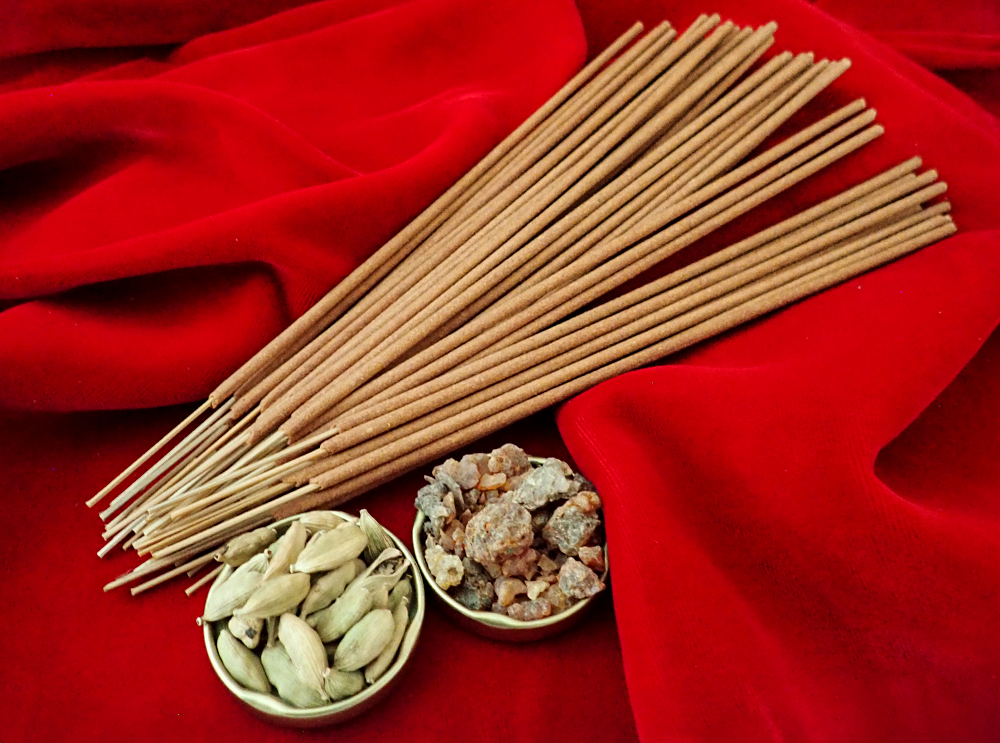
Myrrh was used in the Old testament for the anointing of Priests and Kings as well as burials, symbolically encompassing Christ’s role as King, Priest, and victim in His sacrificial act on Calvary. The myrrh is mixed with cardamon, a perfume used by the Romans…Read more
Flos Carmeli Incense

A floral scent made up of multiple flower fragrances – the word “Carmel” in Hebrew means “garden, choice and cultivated ground” It was on Mount Carmel that Our Lady’s Order of Carmelites began with St. Elias. It is a symbol not only of Our Lady, but of the order that produced such an abundance of the flower of sanctity….Read Moree
Holy Cross Incense

A woody scent combination sweetened by lavender. The cross is a symbol of death (sandalwood) transformed by Christ’s sacrifice into a symbol of life (cypress): “Sweet the wood, sweet the nails, sweet the load that hangs there on.”…Read More
Star of the Sea Incense

A delicate floral scent derived from Jasmine (a small pure white star shaped flower) and water blossoms and named for Our Blessed Mother, who embodies innocence and purity and makes our way smooth and tranquil on our journey to Heaven….Read More
Three Kings Incense

Gold, Frankincense and Myrrh – The gifts of the Magi to the Infant King had symbolic meaning which honored Him and showed their understanding of the mystery of the Incarnation. Gold was given to Kings. Frankincense was burned before God alone. And Myrrh was used in burials – King, God, and man….Read More
Incense Sampler Pack
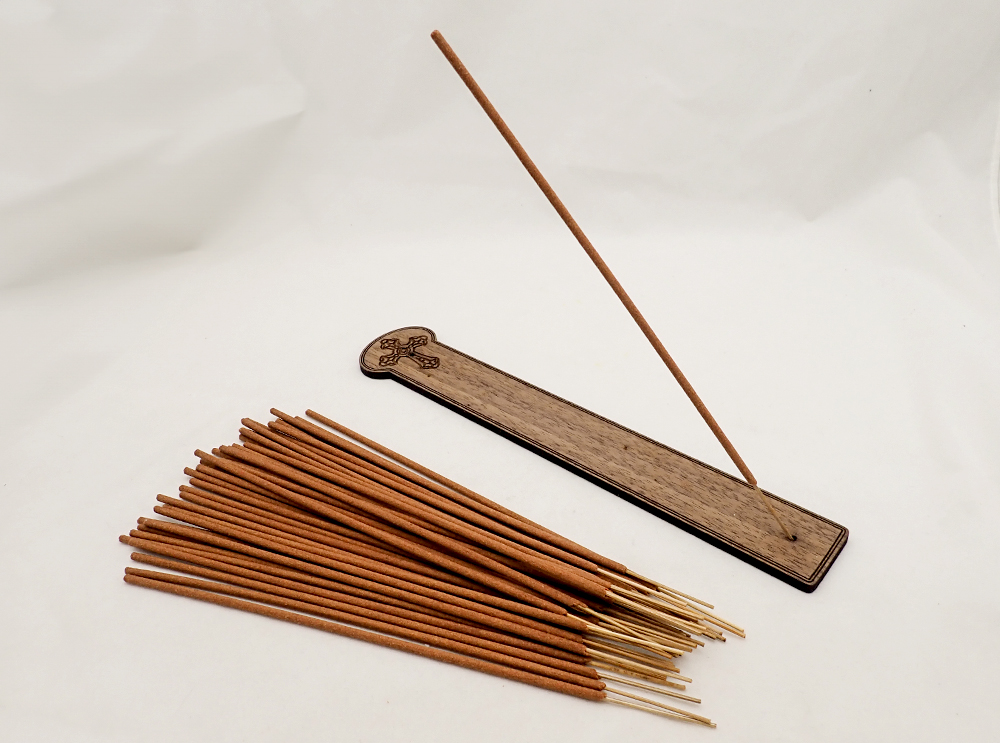
Can’t decide? Try them all! This sample pack contains eight sticks of each Fragrance.
See as well our custom incense holder, with a beautiful laser cut cross design.
Other Carmelite Books
On July 17th, the day following the Feast of Our Lady of Mount Carmel, is a relatively unknown Carmelite feast day, the feast of the Martyrs of Compiegne. These sixteen Carmelite nuns were executed during the reign of terror in the French Revolution for their refusal to abandon their religion and their religious life. Their story was popularized by the book “Song at the Scaffold” as well as a French Opera; but these artistic, dramatic renditions do not tell the actual story. The true story of the martyrdom of this entire Carmelite Community has its origin in their making an act of immolation “to quell the terror” of that horrible revolution. The details of this voluntary offering – and its unmistakable acceptance by almighty God – is carefully chronicled in this very moving book. We have been reading it ourselves as a Community in the refectory.
Written by the same Carmelite author as Divine Intimacy, Father Gabriel of St. Mary Magdalen, this book is a summary of St. John’s teaching. Father Gabriel knew well the daunting challenge that the Saint’s literary works present to the average reader! His desire was to give to all of those sincerely seeking God, especially the laity, a helpful summary and explanation of the St. John’s teachings, which are meant for all generous souls! It is a handbook, a guide on the journey of faith and on the way of prayer and Christian perfection to a total conformity with God’s will. Lay people will find it both helpful and encouraging, not because it waters down in any way St. John’s teaching, but because of the clarity with which it applies to their state of life the demands of detachment and renunciation, without which total surrender to the action of the Holy Spirit is not possible.
This small booklet “packs a punch.” It is the perfect, quick read for anyone who does not know very much about the Brown Scapular and wishes to know more. It can be a powerful tool for spreading the devotion, as it includes the history of the sacramental, what the popes have to say about it, stories of miracles obtained through the Scapular, and even the benefits non-Catholics can receive by wearing it. For a more detailed and expansive book about the Scapular devotion, see the book Mary In Her Scapular Promise
Many are familiar with the famous autobiography of St. Therese, Story of a Soul. Lesser known, but rapidly growing in reputation, is the story of Elizabeth of the Trinity. This book describes her brief life and presents her profound writings. Her deep spiritual life drew its strength from the doctrine of the Divine Indwelling. Those who are drawn to living continually in God’s presence and always keeping company with God who dwells in their souls will find this book replete with spiritual treasures.
